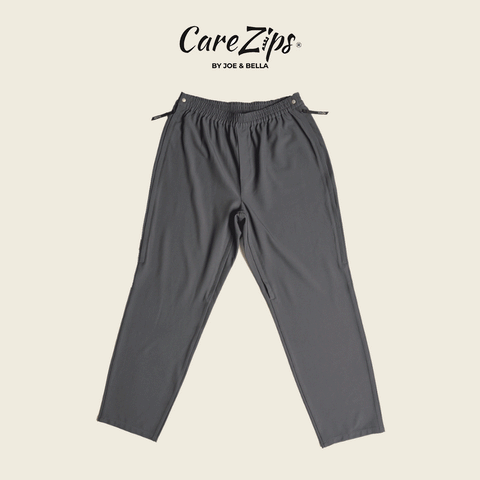Clothing for Parkinson’s Patients Makes Dressing Easier
Clothing for Parkinson’s Patients Makes Dressing Easier, And More Dressing Tips

Here are five great dressing tips to make putting on clothes for Parkinson’s patients so much easier. As you are aware, Parkinson’s can make many simple tasks much more difficult. One particularly notable example is getting dressed and undressed. A former routine, which required little thought, now requires more time, care and planning. And of course that increased challenge can make this twice-daily situation frustrating, especially as the disease progresses. The key: make a plan. Here are five practical tips that should make dressing and undressing a bit easier! And of course, check out Joe & Bella’s line of adaptive wear for easy-dressing options – these are perfect clothes for Parkinson’s patients!
1. Practice Patience: Getting Dressed with Clothes for Parkinson’s Patients Might Take Longer than Before
Just like heading home from work as rush hour hits, this ride will take longer than you’d like. By accepting the fact that dressing will now take more time, you’ll be better able emotionally to handle this life change. Think about clothes for Parkinson’s patients as the vehicle that will help you get home faster – but you’ll still need to follow the directions and rules of the road.
Here’s an obvious but important dressing tip for Parkinson’s: Don’t rush it. If you’re trying to hurry home in the middle of rush hour, you won’t get there any faster. But you’ll have picked up a big ball of Stress and Anxiety on the way. So give yourself plenty of time. There’s no need for an aspect of your daily routine to be stressful. If you take meds in the morning that manage symptoms of Parkinson’s, it might be a good idea to wait for the meds to kick in before getting dressed.
2. Set Yourself Up for Success: Create a Plan. Make it Routine

Control your routine by making it routine. Similar to the previous point, reflect on what it is that makes changing clothes with Parkinson’s the most difficult for you and think through ways to make it a bit easier. If you keep your schedules as consistent as possible, you’ll reduce the need to rush and stress.
If you feel particularly stiff in the morning, doing a light warmup or easy stretching could make getting dressed a whole lot easier. If you have one arm or leg that typically experiences more stiffness than the other, put that limb into the sleeve or pant leg first, followed by the more limber one.
3. Stay Stable: Find the Right Spot. And the Right Chair.

Getting dressed while sitting down is a whole lot easier than when standing.
There’s no reason to act like you’re a Cirque du Soleil gymnast, balancing on one foot or moving your body in unnecessary ways. Pick a spot that gives you plenty of space to reach for your clothes. Choose a chair with firm support and arms. A kitchen chair might not be the best option if it will tip over as you lean to one side. A wider chair is a better choice as it provides you enough space to move around, and arm rests will give you something to hold on to when leaning to one side.
4. Use Specific Clothes for Parkinson’s Patients: Find Products that Work for You

There are so many new options out there that will make dressing easier for someone who lives with Parkinson’s Disease.
Adaptive Apparel will make your life much simpler. Shoes that you can easily slip into; shirts with magnets instead of buttons; and pants with size zippers will become your favorite type of clothing. There are many brands that are innovating in this space, creating clothing with smart functionality while also still looking stylish and feeling comfortable. From Friendly Shoes, to Slick Chicks, to Joe & Bella, these new brands are creating inclusive clothing that you should be wearing.
And don’t overlook adaptive equipment either – button hooks, dressing sticks, zipper pulls, or even devices to help pull up socks — will make getting into your traditional clothing easier than without. Of course, we’d recommend finding adaptive clothing, but these tools are great for those clothing items that you love and don’t want to give up wearing.
5. Choose Clothes Wisely: Some Fabrics and Footwear Should be Avoided

Fabrics that cling or create friction make for frustrating dressing experiences. Avoid velour and similar fabrics, as well as any clothing that might be too tight or form fitting.
Here’s an important dressing tip for Parkinson’s to consider. Non-skid socks are a safer option than bathroom slippers, which can slide off your feet and create a fall risk. Not all non-skid socks are the same, however; so make sure you find a pair that truly help reduce the risk of slipping and falling. And avoid socks with too tight an elastic band.
Find lightweight, supportive shoes that you can slip right into. Along with Friendly Shoes, we love the brand Kizick, because it’s so easy to just step in without dealing with laces or forcing your foot into the heel.

























